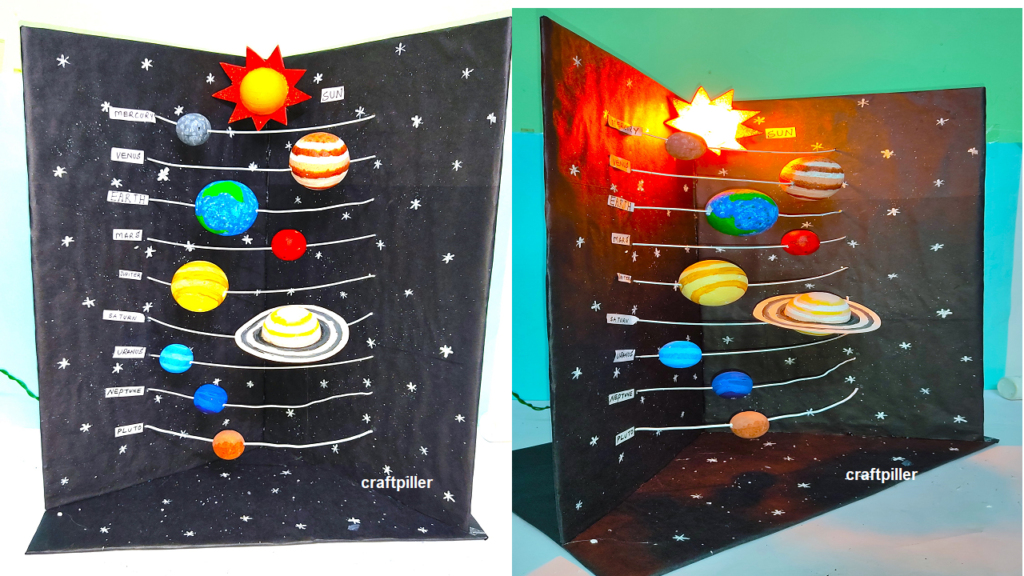In this post we write about making of the solar system working model using the materials available at home
A solar system working model using cardboard, balls, and light to demonstrate the relative positions and movements of the planets in our solar system.
This model demonstrates the relative positions and movements of the planets in the solar system by using cardboard strips to represent the orbits of the planets and placing the planets on their corresponding orbits.
A light source is used to shine on the sun and the planets to simulate the movement of the planets around the sun.
Steps to make the working model of solar systems
Here are the steps to make a basic solar system model using cardboard, balls, and light:
- You will need cardboard, paint or markers, small balls (to represent the planets), a light source (such as a flashlight or lamp), and a cardboard stand or base to hold the model.
- Cut cardboard .
- Arrange the planets: Place the planets on their corresponding orbits and use the light source to shine on the sun and the planets.
- You can add details such as rings for Saturn, and moons for Jupiter or other planets.
- Label the sun and the planets to help identify them and make the model more informative.
This is a basic model, and you can add details and make it as complex as you like. You can also add a motor to rotate the model to simulate the movement of the planets.
This model can be used to demonstrate the relative positions and movements of the planets in our solar system, and also to understand the concept of orbits and the distance between planets.
#solarsystem #workingmodel #scienceproject #craftpiller #scienceexhibition #sciencemodel #sciencefair #workingproject

Step by step video instructions on making of the solar system working model
What is the solar system and what are its main components?
The solar system is a collection of celestial bodies that are held together by the gravitational attraction of the sun.
The main components of the solar system include the sun, the eight planets (Mercury, Venus, Earth, Mars, Jupiter, Saturn, Uranus, and Neptune), and their moons, as well as dwarf planets, asteroids, comets, and other small bodies.
How did the solar system form?
The solar system formed about 4.6 billion years ago from a cloud of gas and dust called the solar nebula. This cloud collapsed and began spinning, eventually forming a protoplanetary disk.
The sun formed in the center of the disk and the planets formed from the dust and gas that surrounded it.
What is the difference between the inner and outer planets?
The inner planets, also known as the terrestrial planets, are Mercury, Venus, Earth, and Mars. They are called inner planets because they are closer to the sun. They are also called terrestrial planets because they are mostly composed of rock and metal.
The outer planets, also known as the gas giants, are Jupiter, Saturn, Uranus, and Neptune. They are called outer planets because they are farther from the sun. They are also called gas giants because they are mostly composed of gas and have much larger sizes than inner planets.
How do the planets move in the solar system?
The planets move in the solar system by orbiting the sun in elliptical paths, which are shaped like an oval. This is due to the gravitational pull of the sun on the planets. The planets also rotate on their own axes, which causes day and night.
How do comets and asteroids differ?
Comets are made mostly of ice and dust, and have a characteristic tail of gas and dust that is created as the comet approaches the sun. They generally have a long, elliptical orbit that takes them far from the sun and back again.
Asteroids, on the other hand, are made mostly of rock and metal, and do not have tails. They are found primarily in the asteroid belt between Mars and Jupiter, and their orbits are generally much shorter and more circular.
How do the sun and the planets affect each other?
The sun and the planets affect each other through the force of gravity. The sun’s gravity keeps the planets in their orbits, while the planets’ gravity affects the sun’s rotation and the distribution of material within the solar system. Additionally, the sun’s energy warms the planets and provides the energy for life on Earth.
How have scientists studied the solar system?
Scientists have studied the solar system by observing it from Earth with telescopes, by launching spacecraft to study the planets and other bodies up close, and by studying the composition and structure of solar system objects with instruments like spectrometers and radar.
What are some of the current and future missions to explore the solar system?
Current and future missions to explore the solar system include NASA’s Perseverance rover on Mars, NASA’s Parker Solar Probe studying the sun, NASA’s James Webb Space Telescope, and missions to explore Jupiter’s moon Europa and Saturn’s moon Enceladus.

